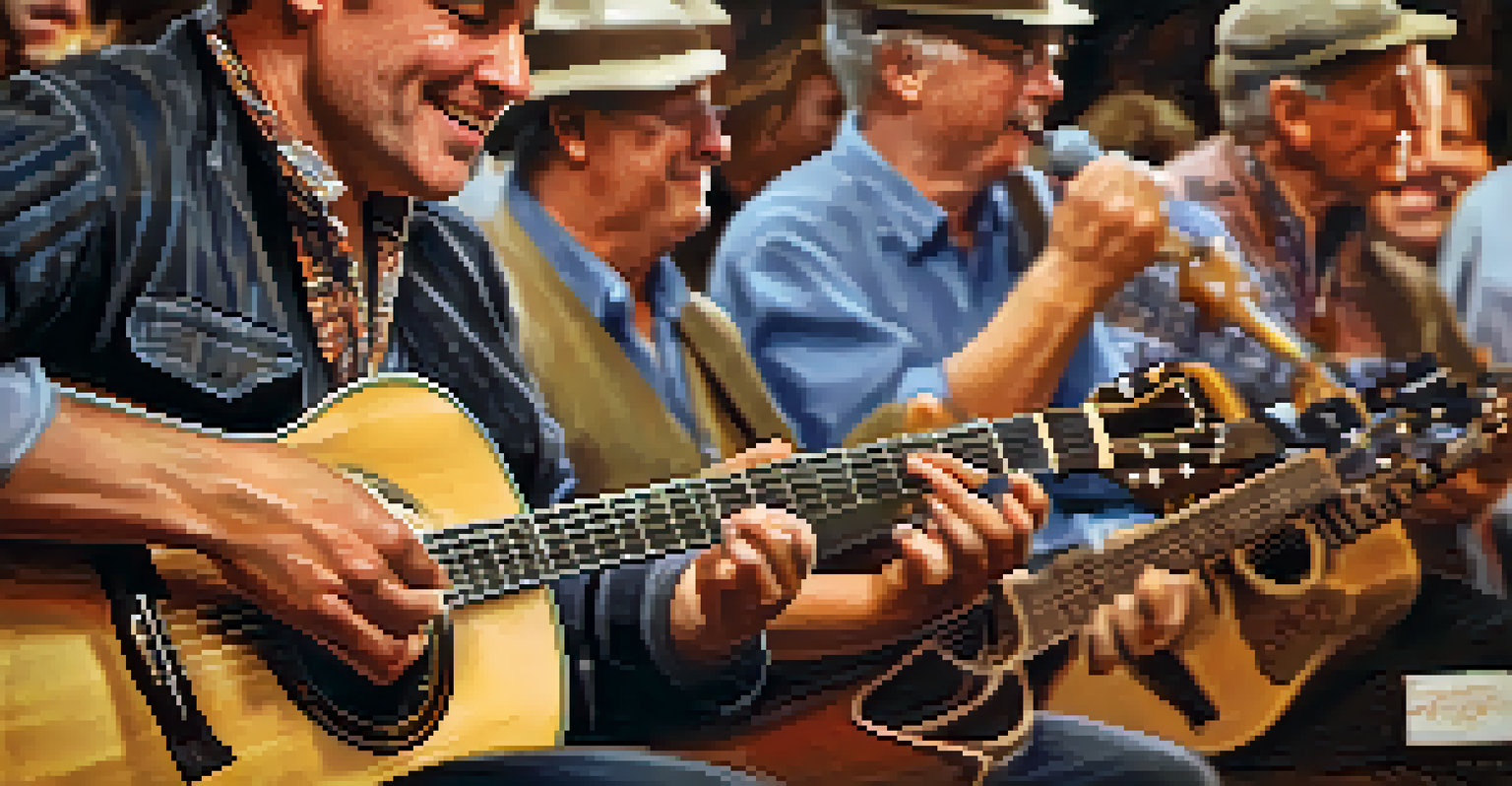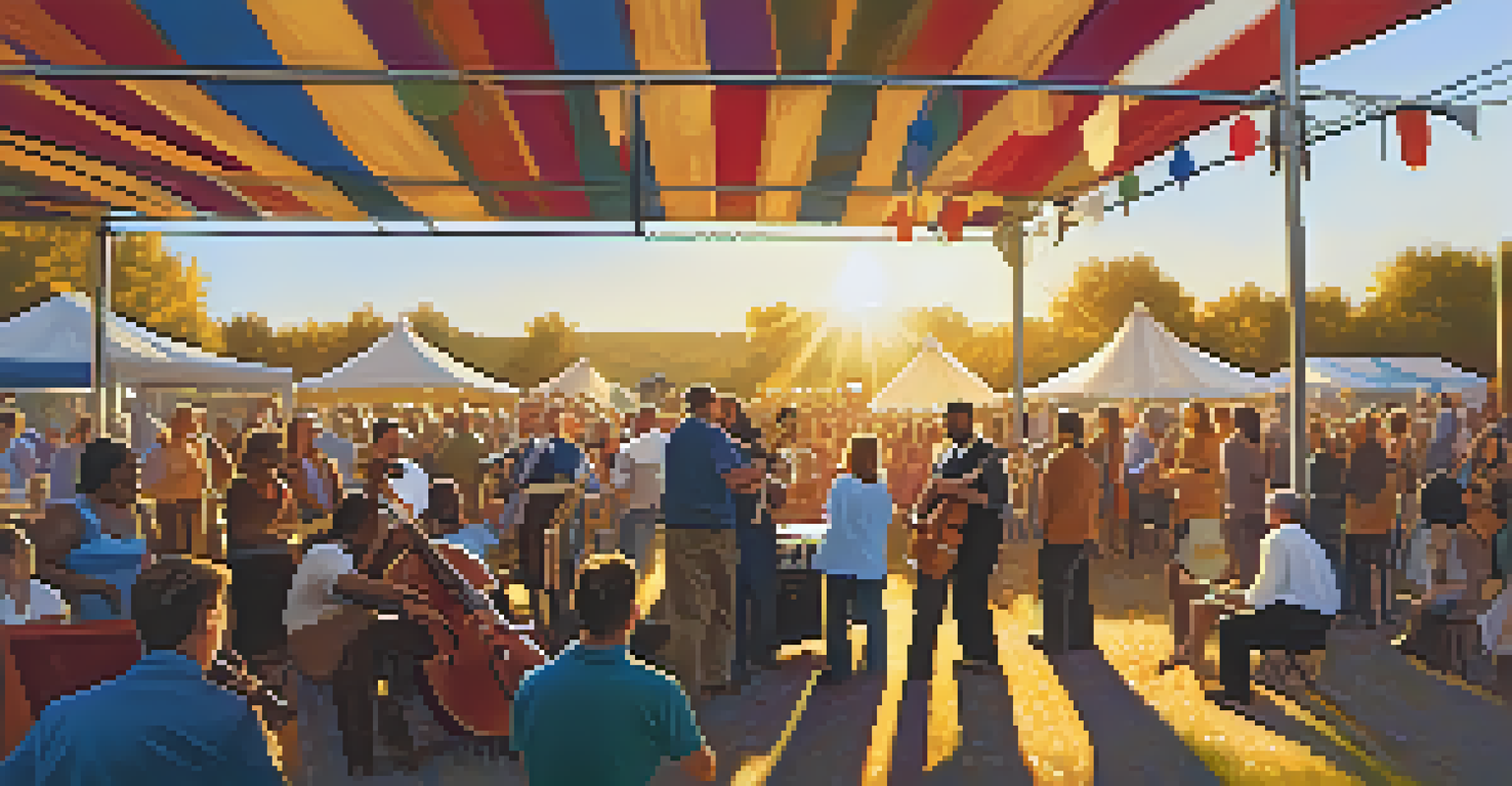Bluegrass Guitar: The Backbone of American Folk Music

What is Bluegrass Music and Its Origin?
Bluegrass music is a genre that emerged in the 1940s, primarily in the Appalachian region of the United States. It blends elements of folk, blues, and jazz, creating a unique sound characterized by its distinctive rhythms and instrumentation. The genre was popularized by musicians like Bill Monroe, often referred to as the 'Father of Bluegrass,' who brought the mandolin and guitar to the forefront.
Bluegrass is a music of the heart and a reflection of the soul, deeply rooted in the traditions of American culture.
The roots of bluegrass can be traced back to the traditional music of immigrants from the British Isles, who brought their musical heritage to America. Over time, this music evolved, incorporating African American influences, which added depth and complexity. The guitar, with its versatility and rhythmic capabilities, became a crucial instrument in this blend.
Today, bluegrass continues to thrive, celebrating its rich history while also embracing modern influences. Musicians around the world are drawn to its lively spirit and communal nature, making it a beloved genre in American culture.
The Role of Guitar in Bluegrass Music
In bluegrass, the guitar serves as the backbone of the ensemble, providing both rhythm and harmony. Its role is akin to that of a sturdy bridge, connecting various musical elements while ensuring a cohesive sound. This versatility allows the guitar to support vocal lines and lead instruments like the banjo and fiddle, creating a rich tapestry of sound.

The guitar's rhythmic strumming patterns, often referred to as 'chopping,' add a unique percussive element to the music. This technique involves muting the strings while strumming, producing a sharp, staccato sound that drives the tempo forward. It's a fundamental aspect of bluegrass that energizes performances and invites audience participation.
Bluegrass Origin and Characteristics
Bluegrass music, originating in the 1940s, fuses folk, blues, and jazz, highlighted by its unique rhythms and instrumentation.
Moreover, the guitar also takes center stage during solos, showcasing the player's skill and creativity. These moments often feature intricate fingerpicking and flatpicking techniques, which highlight the instrument's melodic capabilities. Through these solos, guitarists can express their individuality while still paying homage to the genre's roots.
Famous Bluegrass Guitarists Who Shaped the Genre
Throughout bluegrass history, several guitarists have left a significant mark on the genre. One of the most celebrated is Tony Rice, known for his innovative flatpicking style and ability to blend traditional and contemporary influences. His work has inspired countless musicians and elevated the guitar's role within bluegrass.
The guitar is a bridge that connects different musical worlds, allowing us to explore new sounds while honoring our roots.
Another influential figure is Doc Watson, whose fingerstyle technique and mastery of the guitar set a new standard for bluegrass musicians. Watson's ability to seamlessly integrate elements of folk, blues, and bluegrass has made him a legendary figure in American music. His performances continue to resonate with audiences, showcasing the guitar's versatility.
Lastly, we can't forget about Bill Monroe, who, while primarily known for his mandolin playing, also contributed significantly to the guitar's prominence in bluegrass. His band, the Blue Grass Boys, featured exceptional guitarists who helped define the sound of the genre, proving that collaboration is key in bluegrass music.
Techniques That Define Bluegrass Guitar Playing
Bluegrass guitar playing is characterized by several key techniques that enhance its distinct sound. One of the most essential techniques is flatpicking, where the guitarist uses a pick to strike individual notes or chords. This method allows for rapid note sequences, creating that signature driving rhythm that bluegrass is known for.
Another important technique is fingerpicking, which involves using the fingers to pluck the strings instead of a pick. This style adds a softer, more intricate texture to the music, allowing for expressive melodies and harmonies. Guitarists often combine both techniques, showcasing their versatility and creativity.
Guitar's Central Role in Bluegrass
The guitar acts as the backbone of bluegrass music, providing rhythm, harmony, and a platform for solo performances.
Additionally, the use of open tunings is common among bluegrass guitarists, enabling them to achieve a fuller sound and make certain chord shapes easier to play. By experimenting with different tunings, musicians can unlock new sonic possibilities, adding depth to their performances.
The Influence of Bluegrass Guitar on Other Genres
The impact of bluegrass guitar extends beyond its own genre, influencing various musical styles over the years. For instance, the techniques and rhythms found in bluegrass have been absorbed into country music, folk, and even rock. This cross-pollination has enriched those genres, allowing for new forms of expression.
Artists like Emmylou Harris and the Eagles have incorporated bluegrass elements into their music, showcasing the guitar's versatility. The blending of genres creates a dialogue between traditional and contemporary sounds, illustrating how bluegrass continues to inspire musicians across the musical spectrum.
Moreover, the rise of Americana music has further solidified the guitar's role in blending various influences. This genre embraces roots music, drawing from bluegrass, folk, and country, demonstrating the guitar's ability to adapt and thrive in different contexts.
Bluegrass Guitar in Modern Music Scenes
In recent years, bluegrass guitar has found a renewed presence in modern music scenes. Festivals and gatherings celebrating bluegrass have become popular, drawing in new audiences and fostering a sense of community. These events often feature a mix of traditional and contemporary artists, showcasing the genre's evolution.
Social media platforms have also played a pivotal role in reviving interest in bluegrass. Musicians can share their performances, techniques, and collaborations with a global audience, bridging the gap between generations. This accessibility has inspired a new wave of guitarists eager to explore bluegrass and its rich traditions.
Modern Revival of Bluegrass Guitar
Recent years have seen a resurgence in bluegrass guitar, driven by festivals, social media, and innovative collaborations across genres.
Furthermore, collaborations between bluegrass artists and musicians from other genres have led to exciting musical experiments. By merging bluegrass guitar with elements of jazz, rock, and pop, artists are redefining the boundaries of the genre and attracting a diverse audience.
Learning Bluegrass Guitar: Tips for Beginners
If you're interested in learning bluegrass guitar, starting with the basics is essential. Focus on mastering fundamental chords and strumming patterns, as these will serve as the foundation for your playing. Online tutorials and instructional videos can be valuable resources for beginners, providing step-by-step guidance.
Once you feel comfortable with the basics, experiment with flatpicking and fingerpicking techniques. Try to find a few simple bluegrass songs to practice, as playing along with recordings can help develop your timing and rhythm. Don't be afraid to make mistakes; they are a natural part of the learning process.

Lastly, consider joining a local jam session or bluegrass group. Playing with others not only enhances your skills but also immerses you in the community. You'll learn new techniques, gain confidence, and make connections with fellow musicians who share your passion for bluegrass guitar.